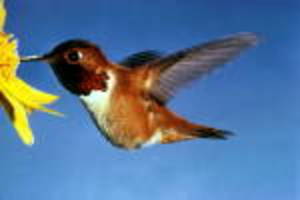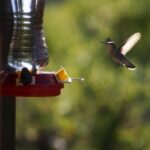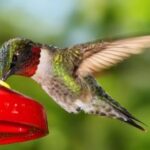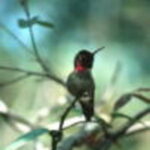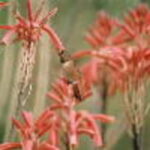Hummingbirds in Indiana? Yes, there are two species of hummingbirds that visit Indiana on their yearly travels. These are the Ruby-throated Hummingbird and the Rufous Hummingbird. Even though there are only two species of hummingbirds in Indiana during migration periods, these tiny visitors are on many people’s minds as they plan, plant and manage gardens on their property or as they shop, buy and maintain hummingbird feeders for their tiny guests.
Even though only two species of hummingbirds visit Indiana regularly, there may be more that happen to follow this migration route, but not in such high numbers as the Ruby-throated hummingbird or the Rufous Hummingbird. Knowing what these two common species look like will help determine if a visiting hummingbird is an uncommon one, or if it is simply one of the tiny guests that the hummingbird enthusiast has been patiently waiting on to arrive.
The male Ruby-throated Hummingbird is the easiest to identify, probably of all species of hummingbirds. Its name gives away the easiest characteristic it has for identification, its ruby colored throat. This tiny male bird also has an emerald colored back and a forked tail. Unfortunately, the female Ruby-throated Hummingbird is not as brightly colored as the male, making it harder to determine which species it actually is, because the majority of female hummingbirds are not the brightly colored of the two sexes. However, with careful inspection, the female can be identified with having the same emerald colored back as the male, but she will have a white breast and throat and her tail has white tips and is round instead of forked.
Just like the male Ruby-throated Hummingbird, the male Rufous Hummingbird is the easier of the two sexes to identify. He also has a characteristic that lends itself to this bird’s name, its rufous colored crown, tail and sides. This male hummingbird also has feathers on its back that are green, rufous or a combination of these two colors, its breast is white and its throat is an orange-red. The female Rufous Hummingbird has a green back and crown, a white breast and a streaked throat. The female’s tail feathers are rufous with white tips. Even though these two species of hummingbirds in Indiana are different in color, they are about the same size. The male Ruby-throated Hummingbird weighs about 3.1 grams and the female will weigh just a little more. The male Rufous Hummingbird weighs about 3.2 grams and its female will also weigh a little bit more. So identifying them by size alone will not work. Learning the differences in their colorations is the best way to identify them.
However, perhaps the easiest way to identify these tiny little birds is by using the calendar. Fortunately, for hummingbird enthusiasts in Indiana, these birds visit Indiana at different times of the year on their annual migration from North to South or from South to North. Ruby-throated Hummingbirds have a tendency to arrive in Indiana in April, with the first ones being seen usually the first week of April and they generally have left Indiana by the end of September. Now this does not mean that there will not be a Ruby-throated Hummingbird in Indiana after September or before April, this is just when they are generally seen. The Rufous Hummingbird usually passes through Indiana on its journey South, in November and will usually stay until late in January.
Hummingbirds in Indiana are just like hummingbirds in any other state; certain trees and shrubs, vines and flowers, including perennials and annuals, attract them. Trees and shrubs that are preferred by hummingbirds are azalea, butterfly bush, cape honeysuckle, flame acanthus, flowering quince, lantana, manzanita, mimosa, red buckeye, tree tobacco, Turk’s cap and Weigelia. Vines preferred by hummingbirds are coral honeysuckle, cypress vine, morning glory, scarlet runner bean and trumpet creeper. Perennial flowers preferred by hummingbirds are bee balm, canna, cardinal flower, columbine, coral bells, four o’clock, foxglove, Hosta, hummingbird mint, little cigar, lupine, Penstemon and yucca. Annual flowers preferred by hummingbirds are beard tongue, fire spike, fuchsia, impatiens, jacobiana, jewelweed, petunia, salvia and shrimp plant.
